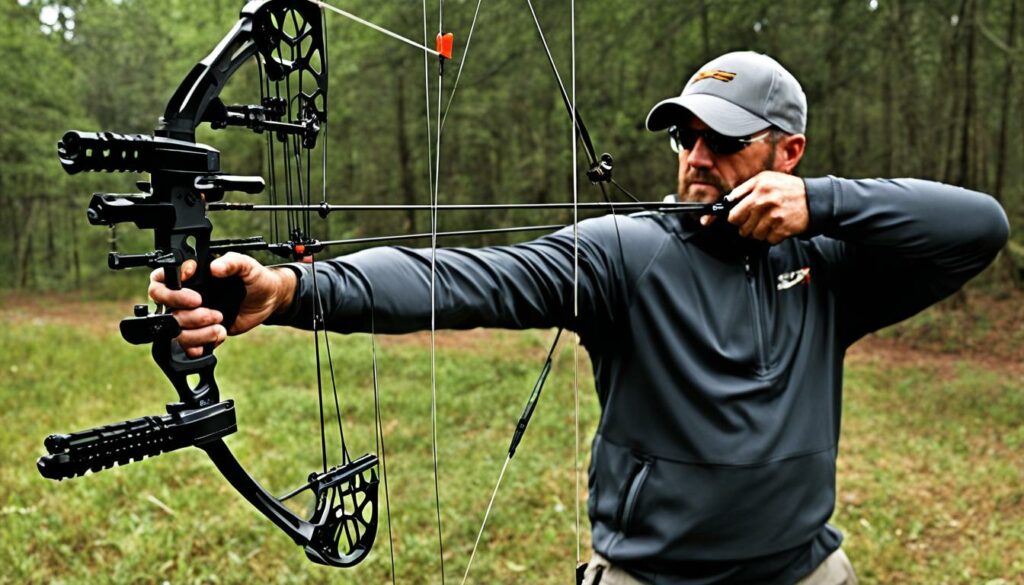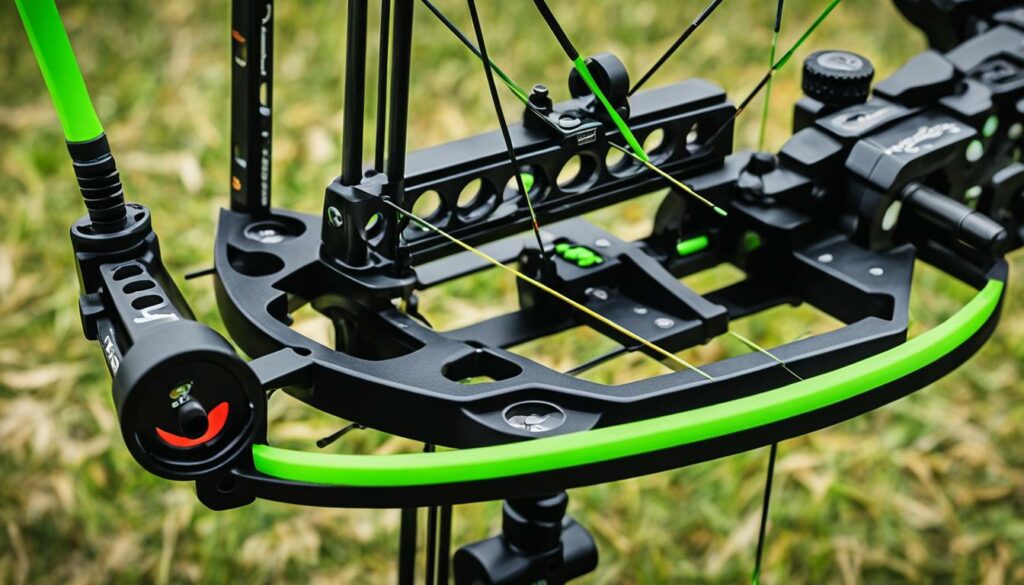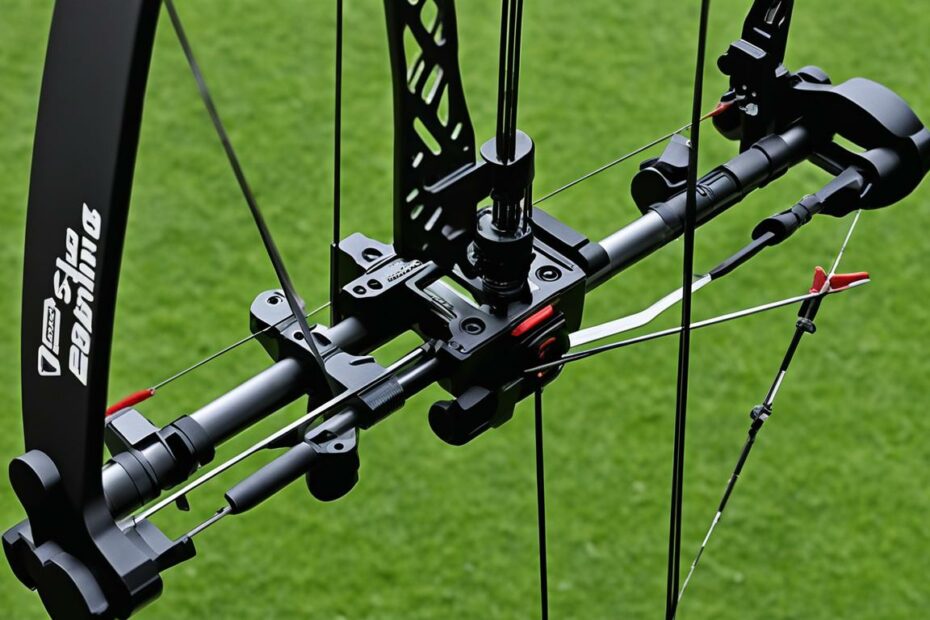Compound bow stabilizers are essential accessories that improve stability and accuracy during archery. Understanding how these stabilizers function can significantly enhance your shooting performance, whether you’re a seasoned archer or a beginner.
So, how do compound bow stabilizers work exactly? These ingenious accessories reduce bow movement and vibrations upon release, producing more precise shots. Stabilizers provide a smoother aim and release process by enhancing stability, leading to better overall performance.
Stabilizers achieve this by increasing the weight of the bow, which in turn improves the bow’s moment of inertia. This increased stability allows archers to have better control and minimize any hand or arm movements that may affect aim and accuracy.
Also, stabilizers help balance the bow and reduce motion, improving accuracy and consistency. This is especially beneficial for archers who often engage in long-distance shooting, where even the slightest movement can significantly impact the arrow’s trajectory.
The Benefits of Bow Stabilizers
Bow stabilizers offer several benefits to archers. They serve as a performance enhancer for compound bows by improving stability and accuracy. With their vibration-dampening capabilities, stabilizers reduce hand and arm fatigue, ensuring a comfortable shooting experience. Let’s explore the various advantages of utilizing bow stabilizers.
Improved Stability for Precise Shots
One of the primary benefits of bow stabilizers is their stability during shots. By balancing the bow’s weight distribution, stabilizers reduce unwanted motion, resulting in improved accuracy and consistency. This stability is crucial for long-distance shots, where even minor movements can significantly affect the arrow’s trajectory.
Efficient Vibration Dampening
Stabilizers also excel at vibration dampening in compound bows. When the bowstring is released, it generates vibrations that can affect aim and accuracy. However, with vibration-dampening materials and technology, stabilizers absorb these vibrations and mitigate their negative impact.
This improves performance and helps prevent injuries that can result from excessive vibration transfer to the shooter’s hands and arms.
Noise Reduction and Stealthy Hunting
In addition to stabilizing shots and damping vibrations, bow stabilizers reduce noise. This makes them an excellent choice for bowhunters who require stealthy approaches when targeting animals. By reducing bow noise, stabilizers enable archers to remain undetected and increase their chances of a successful hunt.
How Stabilizers Improve Shot Stability
Stabilizers enhance shot stability by addressing key factors affecting an archer’s aim and release. They achieve this by adding weight to the front end of the bow, allowing for a more balanced distribution and reducing unwanted movements and vibrations.
Let’s explore how stabilizers contribute to shot stability by balancing compound bows, reducing bow torque, and minimizing bow jump.
1. Balancing Compound Bows
When accessories like sights, arrow rests, and quivers are mounted on one side of the bow, it can create an imbalanced weight distribution. This imbalance can lead to unintended movements and instability during shooting.
Stabilizers help counterbalance the uneven weight by adding more weight to the front end of the bow, resulting in a more stable and steady hold. This balance allows the archer to maintain better control and accuracy throughout the aiming and release process.
2. Reducing Bow Torque
Bow torque refers to the tendency of the bow to lean to one side when the string is released. This can negatively impact shot stability, especially when shooting with high draw weights. Stabilizers are designed to reduce bow torque by counteracting the rotational forces generated upon release.
The added weight and length of the stabilizer help resist these forces, resulting in a steadier hold and a more controlled shot. By minimizing bow torque, stabilizers enable archers to achieve improved accuracy and consistency in their shots.
3. Minimizing Bow Jump
Bow jump refers to the upward movement of the bow after releasing an arrow. This movement can affect the archer’s follow-through and potentially compromise the accuracy of subsequent shots. Stabilizers are crucial in reducing bow jump by absorbing and dampening the energy generated upon arrow release.
The added weight and stability the stabilizer provides help minimize the upward movement, allowing the archer to maintain better control and focus on their aim. This reduction in bow jump contributes to more accurate and consistent shooting performance.

How Stabilizers Dampen Vibrations
Stabilizers have advanced technology that effectively reduces bow vibrations, improving shooting performance. These innovative accessories utilize design elements and materials to dampen the vibrations generated upon releasing the bowstring.
One key component of bow stabilizer technology is the integration of rubber dampeners. These dampeners are strategically placed along the stabilizer’s body, absorbing and dispersing the vibrations away from the bow. This technology reduces the intensity of vibrations and minimizes their duration, allowing archers to maintain a steady aim and follow through.
The dampening effect of stabilizers serves multiple purposes. Firstly, it increases shooting comfort by reducing the amount of hand movement caused by vibrations. This reduced hand movement minimizes the chances of unintentional disruptions to aim and accuracy.
Additionally, bow stabilizers significantly reduce overall bow vibrations, which can cause fatigue and strain, especially during extended shooting sessions.
Manufacturers have also introduced stabilizers with flexible shock absorbers. These shock absorbers further enhance the stabilizer’s dampening capabilities, providing archers with a smoother and more enjoyable shooting experience.
These absorbers’ flexibility enables them to absorb vibrations efficiently, mitigating their impact on the archer’s hand and arm.
Archers must use stabilizers with vibration-dampening technology to achieve optimal shooting performance.
Now, let’s take a look at a table that highlights some popular stabilizers known for their vibration-dampening capabilities:
| Stabilizer Brand | Vibration Dampening Features |
|---|---|
| Brand X | – Rubber dampeners – Flexible shock absorbers |
| Brand Y | – Multiple rubber dampeners – Integrated vibration absorbers |
| Brand Z | – Dual chamber design for vibration dispersion – Advanced polymer-based dampeners |
These stabilizers incorporate cutting-edge technology to ensure optimal vibration reduction, making them popular among archers seeking superior shooting comfort and performance.
Bow stabilizers, which focus on vibration dampening, enhance the archer’s shooting experience. By effectively reducing bow vibrations, these accessories provide the stability and control necessary for precise and accurate shots.
Now that we understand how stabilizers dampen vibrations let’s explore the key factors to consider when selecting the right stabilizer in the next section.
Choosing the Right Stabilizer
Several factors must be considered when selecting a bow stabilizer, which can greatly impact shooting performance. The stabilizer’s length, weight, and design are all essential elements that should be considered.
The length of the stabilizer plays a crucial role in determining stability and maneuverability. Shorter stabilizers are ideal for shooting in tight spaces, such as hunting blinds, where a compact setup is necessary. On the other hand, longer stabilizers provide more excellent stability and are favored by target shooters who prioritize steady aiming and consistent shots.
The weight of the stabilizer is another vital consideration. It should be chosen based on your individual strength and shooting style.
Heavier stabilizers offer enhanced stability by reducing bow movement and absorbing vibrations. However, balancing weight and ease of handling is essential to ensure optimal comfort and control.
Various design options are available in the market. Some popular choices include poker stabilizers, twin stabilizers, and reverse stabilizers.
The design you choose should align with your preferences and shooting requirements. Experimentation and trying out different designs can help you find the stabilizer that best suits your needs.
Summary:
| Factors | Considerations |
|---|---|
| Stabilizer Length | Shorter stabilizers are for tight spaces, and longer stabilizers are for enhanced stability. |
| Stabilizer Weight | Choose a weight that balances stability and ease of handling. |
| Stabilizer Design | Select a design that aligns with your preferences and shooting requirements. |

Setting Up Your Stabilizer
Setting up a bow stabilizer requires careful adjustment and experimentation. Archers can optimize their stabilizers’ performance and improve shooting accuracy by following proper setup techniques. We will discuss critical steps for setting up front and back bar stabilizers in detail.
Front Stabilizer Setup
The front stabilizer is a crucial component that counterbalances the weight distribution of accessories and reduces bow movement. To set up your front stabilizer:
- Ensure the stabilizer is securely mounted to the bow’s front stabilizer mount.
- Experiment with different stabilizer lengths to find the optimal balance between stability and maneuverability.
- Adjust the weight of the stabilizer by adding or removing weights to fine-tune its effect. Heavier weights provide more stability, but be mindful of maintaining ease of handling.
Back Bar Stabilizer Setup
Back bar stabilizers are crucial in achieving proper bow balance and aiming stability. Here’s how to set up your back bar stabilizer:
- Mount the back bar stabilizer to the bow’s rear stabilizer mount.
- Adjust the angle of the back bar based on your sight picture and bubble level at full draw. Experiment to find the angle that provides the most comfortable and stable aiming position.
- Explore different weight positioning options to achieve optimal balance and stability.
Monitor the sight pattern while aiming regularly to evaluate the effectiveness of your stabilizer setup. Experimentation and adjustments based on personal shooting preferences and shooting performance can help refine your stabilizer setup over time.
Debunking Misconceptions About Stabilizers
Several misconceptions about bow stabilizers can prevent archers from utilizing them effectively. One common misconception is that stabilizers are only for professional archers; in reality, they benefit archers of all skill levels. Whether you’re a novice or an experienced archer, adding a stabilizer to your bow can significantly improve your shooting performance.
Another misconception is that stabilizers are bulky and heavy, which may deter some archers from using them. However, stabilizers come in various designs, including shorter and adjustable options.
These alternative designs cater to different shooting styles and preferences, allowing archers to find the perfect stabilizer that suits their needs.
Furthermore, stabilizers are not limited to target shooting but can significantly enhance the hunting experience. Noise reduction is crucial when hunting to avoid alarming wary games. Stabilizers effectively dampen bow vibrations, resulting in a quieter shot.
Additionally, the increased stability provided by stabilizers during aiming and release ensures more accurate and precise shots, increasing the chances of a successful hunt.
FAQ
How do compound bow stabilizers work?
Compound bow stabilizers enhance stability and accuracy by reducing bow movement and vibrations upon release. They increase the bow’s weight, improving its moment of inertia and balancing the bow for a smoother aim and release process.
What are the benefits of bow stabilizers?
Bow stabilizers offer several benefits, including improved stability, increased accuracy, reduced hand and arm fatigue, and quieter shots. They also help counterbalance accessories mounted on one side of the bow, reduce bow torque, and minimize bow jump for better control and follow-through.
How do stabilizers improve shot stability?
Stabilizers improve shot stability by adding weight to the front end of the bow, balancing its distribution, and reducing motion. This helps archers maintain a steadier aim and release, improving accuracy and consistency.
How do stabilizers dampen vibrations?
Stabilizers incorporate technology, such as rubber dampeners, to absorb and disperse vibrations generated by the bowstring. This vibration dampening increases shooting comfort, prevents unnecessary hand movements, and improves aim and accuracy.
How do you choose the right stabilizer?
When choosing a bow stabilizer, consider length, weight, and design factors. Shorter stabilizers are suitable for tight spaces, while more extended stabilizers provide excellent stability. The weight should be balanced for easy handling, and the design should align with personal preferences and shooting requirements.
How do you set up a stabilizer?
Mount it securely and adjust the resistance to bow movement to set up a bow stabilizer—experiment with adding or removing weights to achieve the desired effect. Adjust the angle and weight positioning for back bar stabilizers to achieve proper bow balance and aiming stability.
What are common misconceptions about stabilizers?
One common misconception is that stabilizers are only for professional archers. Stabilizers benefit archers of all skill levels. They come in various designs, including shorter and adjustable options, catering to different shooting styles. They are also suitable for hunting, reducing noise, and increasing stability during aiming and release.
